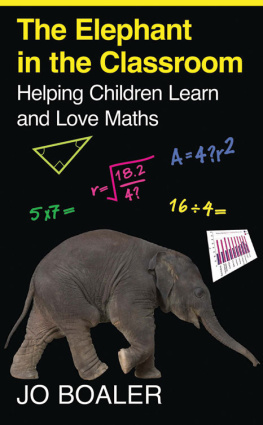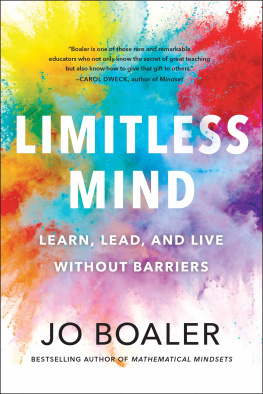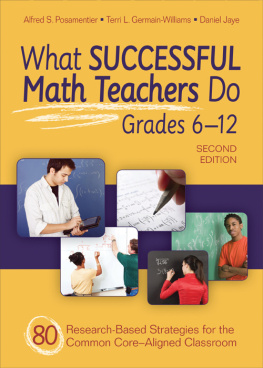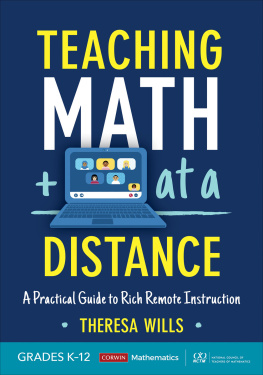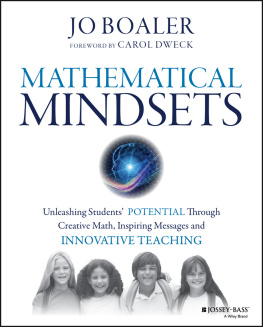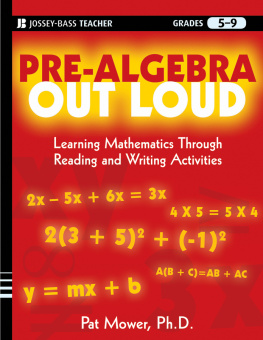Praise for Whats Math Got to Do with It?
Without doubt, this is the most important book parents should read before choosing a school for their child, and teachers should read when considering ways to improve their math teaching. A compelling, readable account of years of research into what works, and what doesnt, in mathematics education.
Keith Devlin, PhD, Stanford University mathematician, award-winning author of The Math Gene and thirty-one other books, and the Math Guy on NPR
Jo Boaler vividly shows usrather than just telling uswhat terrific math instruction looks like and, equally important, how sharply it differs from how the subject is usually taught. Whats Math Got to Do with It? is the first book I recommend to teachers and parents who want to understand the harms of conventional ways of teaching math as well as the benefits of realistic alternatives.
Alfie Kohn, author of The Schools Our Children > Deserve and Feel-Bad Education
There is so much wisdom packed into this engaging little book. Boaler sensibly addresses current hot topicsthe Common Core, mind-set, ability grouping, gender differencesbut goes way behind them to consider the nature of mathematics itself and offers a wealth of practical advice to parents, teachers, and policy makers. More than ever, we need books on education like his one.
Mike Rose, author of Possible Lives: The Promise of Education in America
Whats Math Got to Do with It? comes the closest of anything that I have read to a manifesto that I would provide to parents to help them better understand the importance of good teaching of interesting and complex mathematics.
Journal for Research in Mathematics Education
Jo Boaler shows that math is understandable, and that it can be fun to get your head around itbut that its often taught in ways that make it dry and deadly. She points to the beauty and joy of mathematics, and ways that math classrooms can become centers of lively mathematical thinking. American children deserve a richer mathematical diet than weve given them, and Boaler shows how and why.
Alan H. Schoenfeld, Elizabeth and Edward Conner Professor of Education, University of California, Berkeley
This extraordinary book shows teachers and parents the path to teaching children to enjoy math while they develop deep and flexible understanding. The author practices what she preaches; using systematic research she and others have conducted on two continents, she makes learning about math teaching accessible and fun.
Deborah Stipek, I. James Quillen Dean and Professor of Education, Stanford University
Jo Boaler makes a powerful case for a problem-solving approach to teaching mathematics, and she presents the research to back it up. This book should be read by anyone concerned about the education of our children.
Deborah Schifter, principal research scientist, Education Development Center, Inc.
Jo Boaler explains with insight and clarity why so many students dislike mathematics and what the rest of us can do about it. Her solutions are comprehensive, grounded in research, and powerfully applied by parents, teachers, and anyone else with an interest in mathematics.
Dan Meyer, Apple Distinguished Educator and one of Tech & Learning s 30 Leaders of the Future
PENGUIN BOOKS
WHATS MATH GOT TO DO WITH IT?
Jo Boaler is a professor of mathematics education at Stanford University and the cofounder of YouCubed. She is also the editor of the Research Commentary section of The Journal for Research in Mathematics Education (JRME) and author of the first Massive Open Online Course (MOOC) on mathematics teaching and learning. Former roles have included being the Marie Curie Professor of Mathematics Education in England. She is the recipient of several awards, an adviser to Silicon Valley companies, and a White House presenter on girls and STEM (science, technology, engineering, and mathematics) education. She is a regular contributor to national television and radio in the United States and the UK. Her research has appeared in newspapers around the world including the Wall Street Journal , the Times (London), and the Telegraph (UK).
PENGUIN BOOKS
Published by the Penguin Group
Penguin Group (USA) LLC
375 Hudson Street
New York, New York 10014

USA | Canada | UK | Ireland | Australia | New Zealand | India | South Africa | China
penguin.com
A Penguin Random House Company
First published in the United States of America by Viking Penguin, a member of Penguin Group (USA) Inc., 2008
Published in Penguin Books 2009
This revised edition published 2015
Copyright 2008, 2015 by Jo Boaler
Penguin supports copyright. Copyright fuels creativity, encourages diverse voices, promotes free speech, and creates a vibrant culture. Thank you for buying an authorized edition of this book and for complying with copyright laws by not reproducing, scanning, or distributing any part of it in any form without permission. You are supporting writers and allowing Penguin to continue to publish books for every reader.
Photographs by the author unless otherwise indicated.
ISBN 978-1-101-99205-0
While the author has made every effort to provide accurate telephone numbers, Internet addresses, and other contact information at the time of publication, neither the publisher nor the author assumes any responsibility for errors or for changes that occur after publication. Further, publisher does not have any control over and does not assume any responsibility for author or third-party Web sites or their content.
Version_1
Contents
For all the teachers who have inspired my work
Acknowledgments
This book has been a journey of opportunities. Over recent years I have been able to learn from some of Americas most inspirational teachers and their students, and to work alongside visionary friends and colleagues who have broadened and enriched my thinking. I am deeply grateful to many people in California, particularly at Stanford University and in Bay Area schools, who made this book possible.
This book was conceived at a very special place: the Center for Advanced Study in the Behavioral Sciences in California, a place devoted to the generation of ideas. I had given a presentation to the other fellows at the center, a group of scholars who worked in different areas of social science research, on the results of my studies of mathematics learning. The group responded strongly, with expressions of shock and dismay, and they urged me to get my results out to the general public. They convinced me to write a book proposal for a broader audience and many peoplein particular Susan Shirk, Sam Popkin, and David Clarksupported me along the way.
From that point I was greatly encouraged by my agent Jill Marsal and Kathryn Court, of Penguin Books, both of whom believed in the book, which meant a lot to me. I wrote the book in the stimulating environment of Stanfords Graduate School of Education, surrounded by a group of graduate students who served as critics and supporters. I would personally like to thank all of my doctoral students, past and present, who contributed to the mathematics education group at Stanford.
I have learned a great deal from some truly inspirational teachers in recent yearsamong them Cathy Humphreys, Carlos Cabana, Sandie Gilliam, Estelle Woodbury, and Ruth Parker. They change students lives on a daily basis and I am privileged to have been able to work with them and learn from them. Cathy is a good friend who has helped me in many ways. I am also deeply grateful to the students of Railside, Greendale, Hilltop, Amber Hill, and Phoenix Park schools; they all gave me their honest and insightful feedback on their mathematics learning experiences and they are the reason that I wrote this book.


